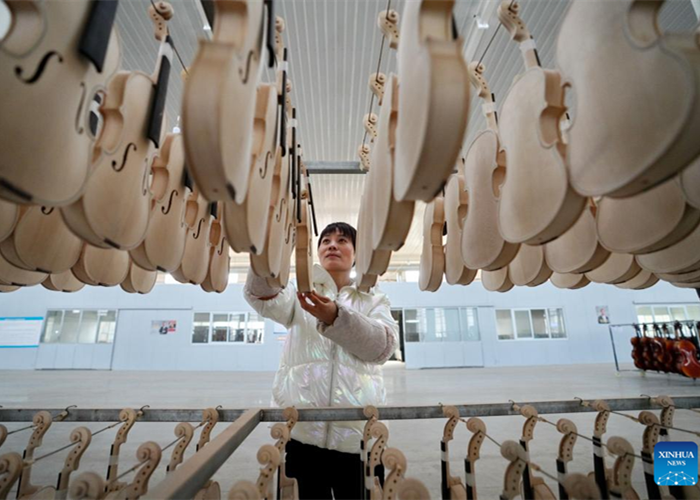In Step with Our Time
Old stories, with their sense of place and time, keep on captivating and inspiring dancer-choreographer Wang Yuanyuan. The founder and director of Beijing Dance Theater, one of the country's most important contemporary dance companies, has adapted some of the most famous Chinese stories and works of literature into her choreographic pieces.
These include Wild Grass, which took its inspiration from the renowned Chinese writer Lu Xun's 1927 poem collection of the same name; The Golden Lotus, a stage adaptation of the 16th-century novel, widely considered to be one of China's most erotic works; and Interrupted Dream, an adaptation of a scene from The Peony Pavilion, a romantic tragedy by Chinese dramatist Tang Xianzu of the Ming Dynasty (1368-1644).
A year ago she started to choreograph a new dance piece based on The Legend of White Snake, one of the most famous Chinese folk tales.
Instead of setting the production against the backdrop of ancient China, Wang propels the classic story into the future when artificial intelligence has moved beyond science fiction and into reality, changing history and touching lives in so many ways-from how humans move, to how they think and how they love.
Titled White Snake — Revelations, the dance production, choreographed and directed by Wang, will be staged between March 24 and 28 at the Tianqiao Performing Arts Center in Beijing. After the premiere, the dance production will kick off a nationwide tour.
The Legend of White Snake is a well-known tale, and has been adapted many times across various art forms, such as TV dramas, movies, Peking Opera productions and dance drama. "It posed challenges for us when we decided to make our own version, but giving the old story a new twist also surprises," says Wang.
The traditional version of the tale tells the love story of a young woman, Bai Suzhen, who is a white snake spirit, and a kindhearted young man named Xu Xian.
Their love and marriage are challenged by a Buddhist monk, Fahai, who believes that humans and demons belong to different worlds.
He then traps the white snake under the Leifeng Pagoda on the bank of the West Lake in Hangzhou.
In Wang's adaptation, however, the white snake travels to the future to meet Xu, who has no recollection of their relationship. Fahai tries to stop the white snake from refreshing Xu's memory. The white snake not only has to fight with Fahai but also to communicate with Xu and other people of the future, who are controlled by AI programs.
"The idea of the dance production is wild. We imagine our lives in the future and explore the benefits and risks of AI technology," says Wang. "The story is the same one but audiences will get a fresh perspective."
Set designer Tan Shaoyuan and lighting expert Han Jiang created a stage with subtle changes brought about by light and shadow. Mirrors on the stage use reflection to portray futuristic scenes.
Born and raised in Beijing, Wang started learning Chinese dance at age 10, graduating from the Beijing Dance Academy in 1995 before going on to study contemporary dance choreography.
From 2000 to 2002, she trained at the California Institute of the Arts' School of Dance in Los Angeles, the United States. She was named resident choreographer at the National Ballet of China and was invited to serve as guest choreographer at the New York City Ballet in 2003.
She is widely celebrated for choreographing the ballet Raise the Red Lantern, directed by Zhang Yimou, the dance scenes in director Feng Xiaogang's movie The Banquet, and for her part in the production of the opening ceremony for the 2008 Beijing Olympics.
Since founding the Beijing Dance Theater in 2008 with Han and Tan, Wang has choreographed around 15 dance compositions and toured the world.
Due to the coronavirus pandemic, the company has had to cancel its tours-about 50 shows in seven countries across Europe and North America.
"I had lots of time at home, which allowed me to think about my next project and the future of the company. The company is known for its pioneering works and bold ideas. That's why we wanted to challenge ourselves with White Snake-Revelations," says Wang.
"The pandemic changed lots of things, especially the way people interact with one another. With this new production, we want to talk about communication, humanity and relationships."
During the height of the outbreak in China, to avoid the spread of COVID-19, Wang led her dancers in training through online sessions. She also initiated the idea of shooting online videos that gathered dancers from home and abroad to dance on camera.
"They danced in their homes, on the street or in front of iconic buildings of their hometowns. It was like a torch relay. That was the only way for us to keep in touch with our audience during the days without live performances," recalls Wang. "We just wanted to let them know: We are still dancing."
(Source: China Daily)
Please understand that womenofchina.cn,a non-profit, information-communication website, cannot reach every writer before using articles and images. For copyright issues, please contact us by emailing: website@womenofchina.cn. The articles published and opinions expressed on this website represent the opinions of writers and are not necessarily shared by womenofchina.cn.








 WeChat
WeChat Weibo
Weibo 京公网安备 11010102004314号
京公网安备 11010102004314号